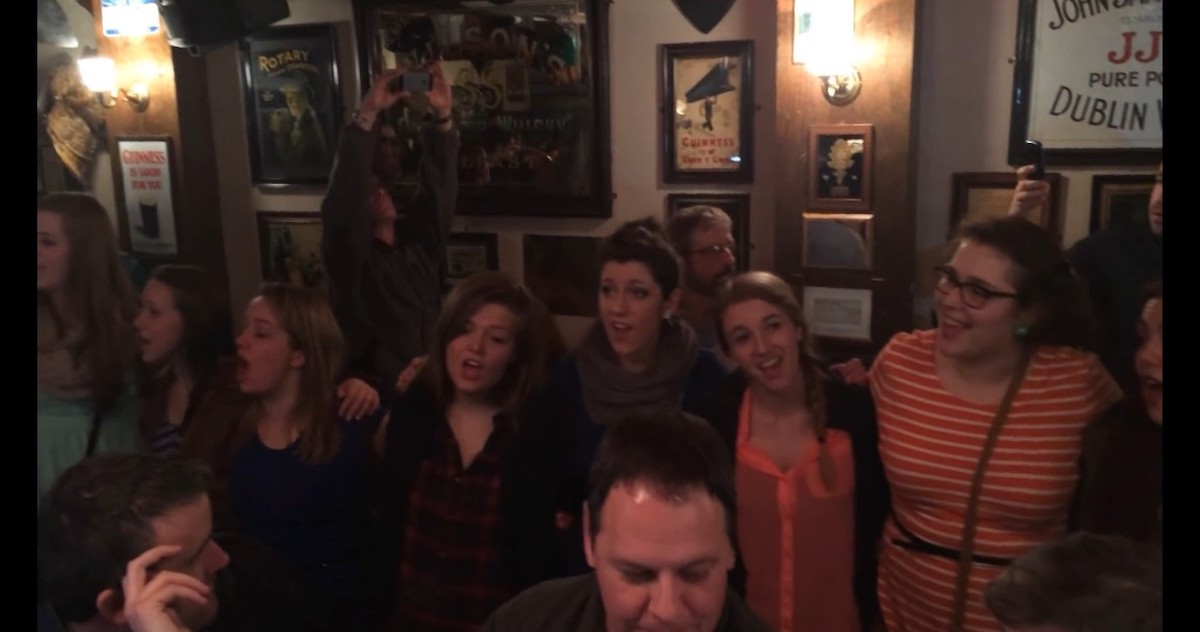It’s a neat irony that Helen Cammock’s The Long Note (2018) has taken on its own complicated history.
Known for a varied practice, stretching across moving image to photography, poetry to printmaking, and taking a sensitive approach to complicated narratives – often addressing her own experience of growing up mixed-race in Britain – Helen Cammock had no particular connection to Northern Ireland. She was, therefore, the exact artist Mary Cremin, director of the Void, felt could address the then upcoming 50th anniversary of the first civil rights march in Derry in 1968.
1968 is an almost mythical year. All across the world, protests against the horrors of Vietnam, the continued injustices faced by people of colour, the oppression of authoritarian regimes and the madness of the Cold War, swept from the United States to the Soviet Union under a loose banner of civil rights, feminism, anti-war, environmentalism and democracy. Northern Ireland was part of this story too.
The story of The Troubles is as much, if not almost exclusively, about civil rights and social justice as it is about sovereignty or nationalism. People marched for housing, for employment, against discrimination, injustice and poverty. It was when these demands continued to be unmet, and the heavy arm of the state pushed back, even shooting unarmed civilians on the street, that paramilitary violence began to take hold. This question of power and justice continues today. Recently, following a long campaign by the Conservative Party, it was ruled in September 2020 that none of the soldiers responsible for Bloody Sunday were to be prosecuted for their actions.
The Long Note (2018) is a film about Northern Ireland against the backdrop of social unrest, and a long one at that. Originally commissioned to be 20 minutes, the running time stands at 1 hour and 39 minutes. It addresses the Troubles, taking a particular focus on the role of women, drawing connections between the Irish and Black civil rights movements. In 2019, Cammock was nominated for the Turner Prize for the piece.
Bernadette Devlin McAliskey, an iconic and outspoken Irish civil rights leader, acts as a kind of main character – but you’d have to recognise her to know this. A dozen or so women feature in the film alongside archival footage and meditative contemporary shots. Yet, they are all nameless. This kind of illegibility of who is speaking suggests different things. It resists easy readings, demanding the viewer have at least a cursory connection with key historical figures; while also restaging the sense of forgetting the women describe. Additionally, it shifts the focus from individual actors to a larger movement which drove and shaped this history.
Through the narrative arc of the film, the layered, multifaceted perspectives outline a broad and varied history. Moments of conflict are portrayed in a notably human manner: describing the casualties, mourning and fallout of the conflict as people turn on each other. But this eventual turn to violence is hardly half the story. Cammock discusses the Irish family albums she encountered, how they held both private moments of weddings, funerals and parties alongside news clippings of public events. In interviews, we hear how the focus by the press and historians on men with guns, the soldiers and paramilitaries, erases the women who kept the families and communities together: a lopsided view of the story which lends all the attention and agency to men. They discuss domestic abuse and struggles for access to contraception. Another woman wonders what the English working-class think of the situation in Derry, if they even know what’s going on.
A pivotal moment occurs when McAliskey recounts the first time she visited America in 1969. It was a turning point for her, an encounter not just with feminism but feminism contextualised alongside race and poverty. Initially, she rejected it: the feminists she encountered were white, middle class and had “more money than I knew people ever to have.” They didn’t carry out the tasks women traditionally did, but neither did the men in their lives. “There was a woman of colour cleaning their house. That was my introduction to feminism.” Looking back, she describes feeling fortunate. This allowed “me to skip the two pages of middle class white feminism.”
This question of solidarity with others, both how it shaped the politics behind the Troubles and to what extent it continues to have relevance today, acts as a startling rallying cry which positions The Long Note not only as an important memorial or an ambitious example of art on the island of Ireland, but a truly great artwork. McAliskey’s reflections are not the end of the piece, but they do frame it. She acknowledges, generously, the inspiration the Irish civil rights movement took from Black Americans, and complains, bitterly, that the same outward, open mindset was not extended by the Irish to others. “It’s sad, you keep having to fight the same battle every generation.” It cuts to Nina Simone playing I Wish I Knew How It Would Feel to Be Free; her performance is commanding. We move to the aftermath of Bloody Sunday, and end on a scene in a present-day pub: a group of women sing arm in arm, swaying in front of a packed crowd, half empty pints and smartphones recording the scene. I sit back, thinking about all that’s happened, all that’s likely to have been forgotten.






